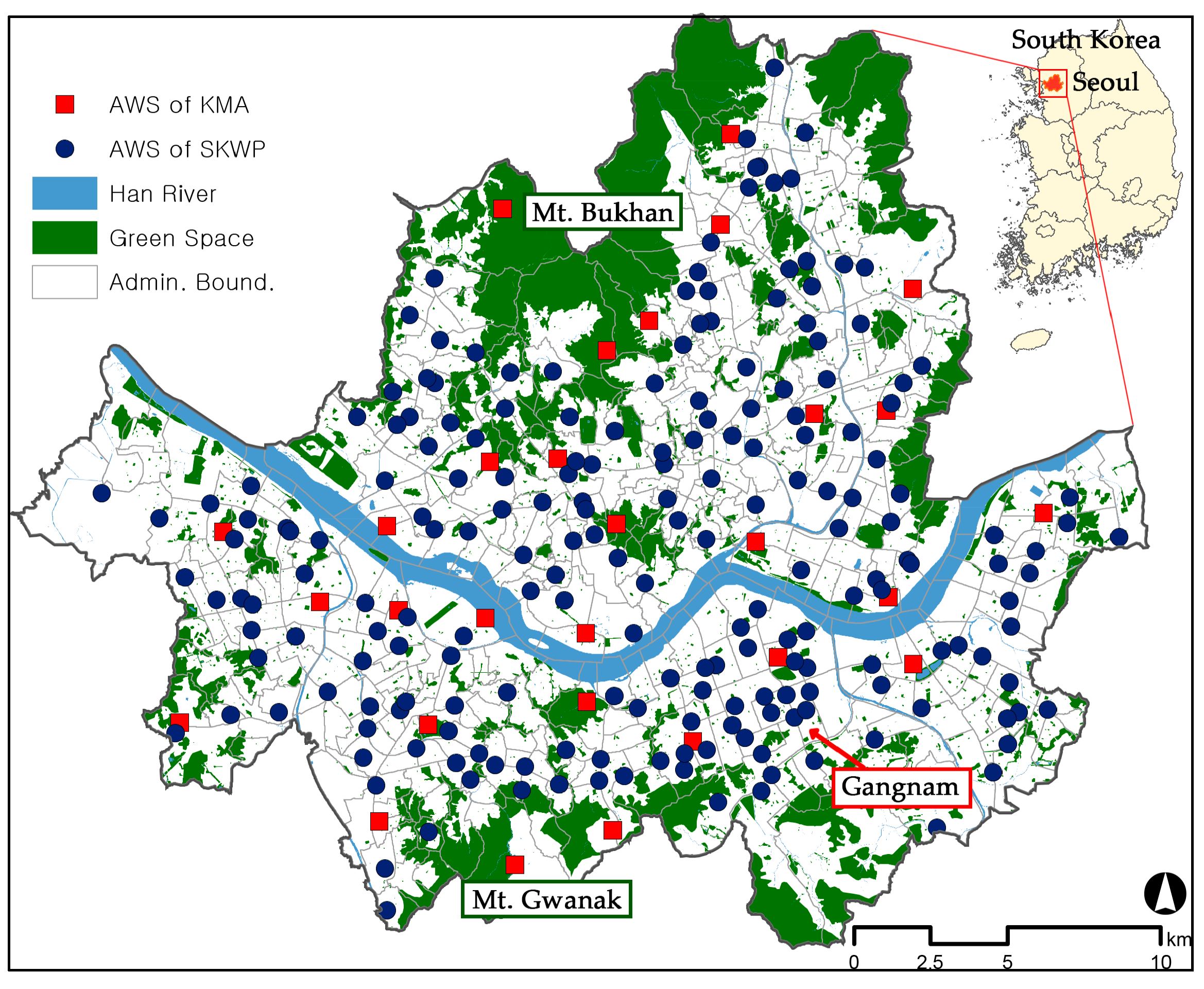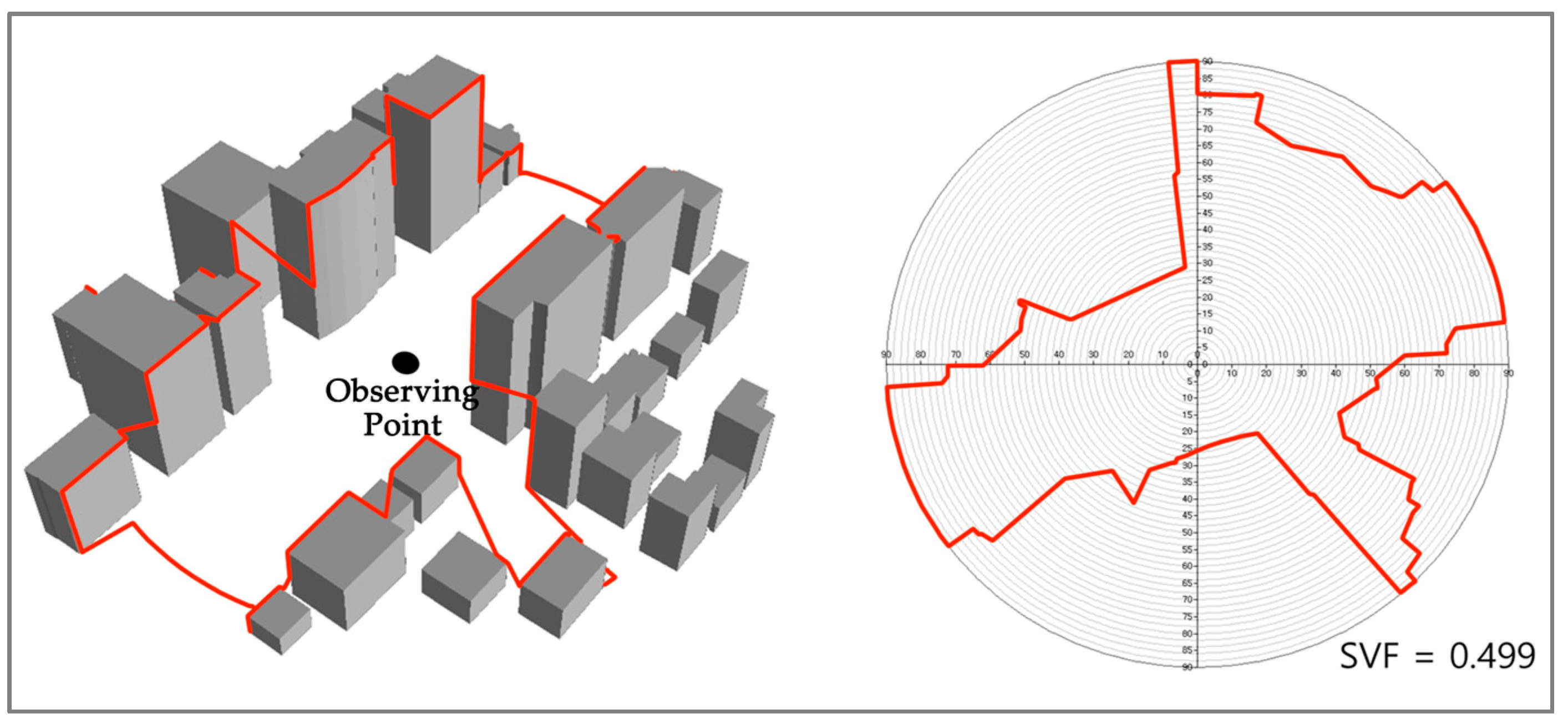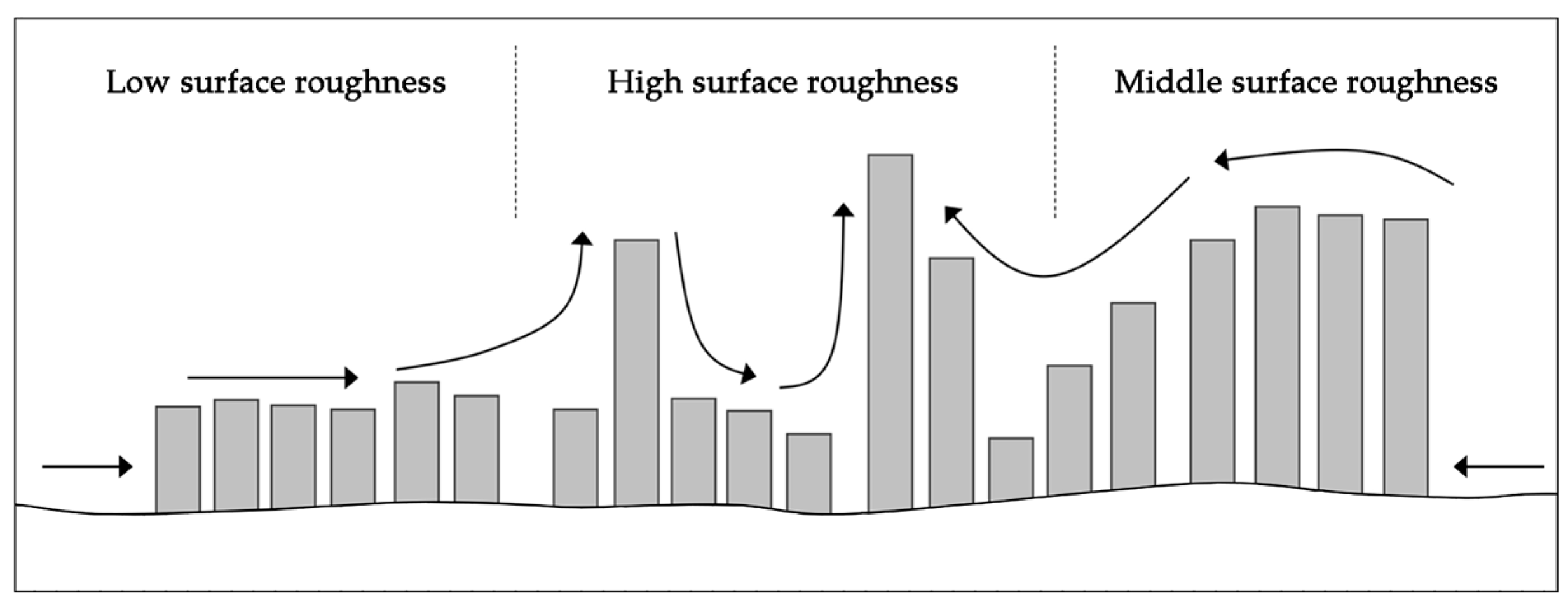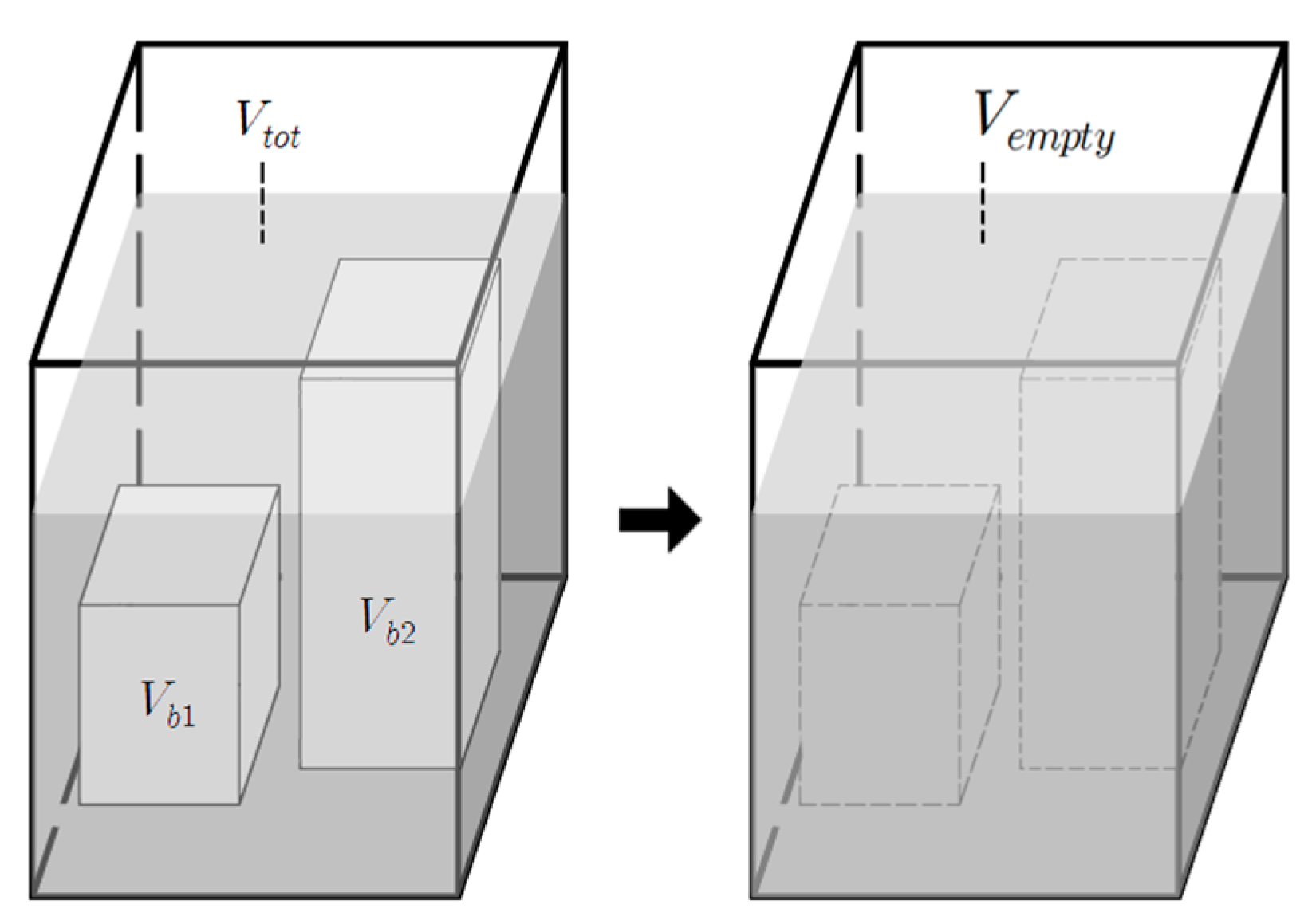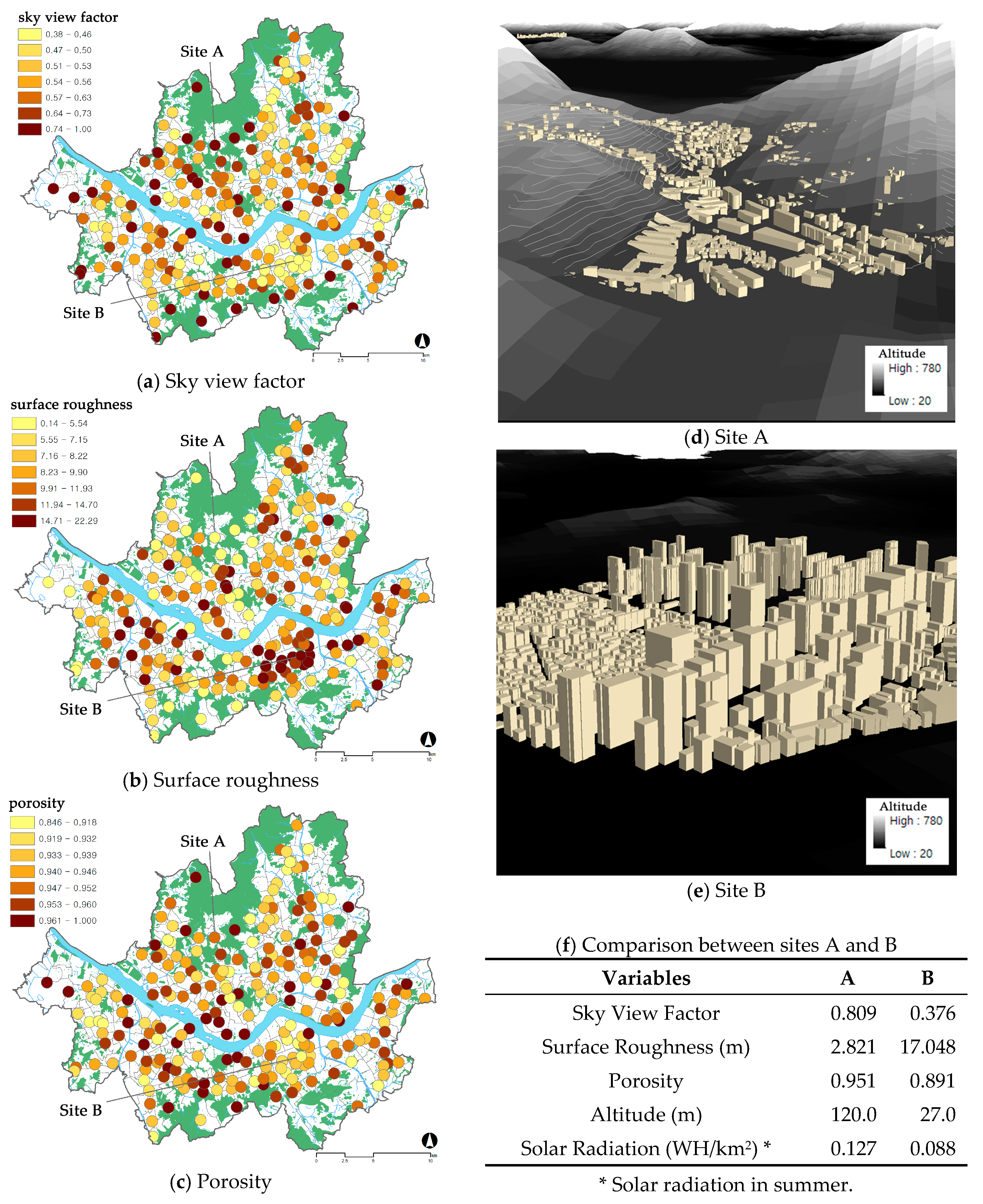1. Introduction
Recently, researchers and policy makers have become interested in mitigation strategies to combat the urban heat island effect and global warming. The characteristics of built environments in urban areas have substantial effects on the urban thermal environment. In particular, the urban heat island effect during the summer is a main threat to the daily lives of urban residents. The consistent and severe heat problems in the summer of 2016 in Korea called public attention to the necessity of mitigation strategies for the urban heat island effect. The high temperature caused by the urban heat island effect during the summer months is an urgent issue that should be dealt with because it increases heat-related illnesses such as heat exhaustion and stroke.
Previous studies suggest that high temperature in the city center is associated with high-density development, large number of impervious surfaces, few green areas, and air pollution [
1,
2,
3,
4,
5]. However, in Hong Kong, the air temperature of the city center was lower than that of the sub-center due to the ventilation effect and the smaller amount of solar radiation [
6,
7]. This result indicates that increasing the building density does not necessarily increase the air temperature in urban areas. Instead, the three-dimensional characteristics of the urban environment can affect the air temperature in a complicated way.
The purpose of this study is to analyze the effect of the three-dimensional built environment on urban air temperature in Seoul. This study examines the relationship between the three-dimensional built environment and urban air temperature as a function of time (i.e., season, time of day). To analyze the built environment factors that affect the air temperature, we applied both two- and three-dimensional built environmental characteristics of urban space including the sky view factor, surface roughness, and porosity level.
2. Literature Review
Several studies have analyzed the relationships between two-dimensional urban characteristics and the thermal environment [
1,
2,
3,
4,
5,
8,
9]. In particular, previous studies have examined the mitigation effect of green space on urban temperature. In studies employing satellite images, such as Landsat data, an increased green space ratio was observed with a decrease in air temperature [
10,
11]. In addition, it was also reported that a single large green space or a number of smaller green spaces could cause a cool island effect, thereby reducing the air temperature [
12]. Previous studies have indicated that the mitigation effect of green space varies according to its density, size, and shape [
13,
14,
15].
Another factor that affects air temperature is albedo, which is the reflection ratio of solar radiation. An area with a high albedo level was observed to show a lower surface temperature [
16]. The albedo level is highly related with the materials of roofing sheets or road surfaces [
17]. Land use was also reported to be a significant factor that affects the urban temperature, especially in areas where human activities increase at night [
18]. Furthermore, anthropogenic heat, including the heat from traffic, human activities, and major facilities, was observed to be an important determinant of the urban thermal environment [
19,
20]. In a study analyzing 47 areas in South Korea, an increase in traffic showed a high association with an increase in urban temperature [
21].
Urban areas that have undergone high-density development with high-rise buildings are more likely to experience an increase in urban air temperature. Therefore, researchers have developed three-dimensional measures such as the sky view factor, roughness, and porosity that can quantify the urban environment [
22,
23,
24,
25]. For instance, a higher sky view factor, which indicates a high ratio of sky visibility at a certain point, decreases the urban temperature. The mitigation effect of the sky view factor can be explained through the canyon effect, which is more likely to decrease the air circulation in areas with lower sky view factor, leading to higher air temperature [
26]. Generally, the sky view factor is lower in areas with many high-rise buildings [
24]. In addition, an increase in sky view factor decreases the urban air temperature during both the day and night [
25].
The roughness of an urban area is used to estimate the arrangement of buildings and open spaces. A lower surface roughness can cause higher wind speeds and form wind pathways that can lower urban temperature and heat stress [
27]. Like surface roughness, roughness length can also be used to estimate wind speed and wind path in urban areas [
28,
29]. Since cool wind from suburban areas or green spaces can decrease urban temperature, the wind path is an important factor for mitigating urban heat islands [
30]. On the other hand, porosity, which is the ratio of vacant space, is a significant index for urban street canyons. Low porosity can disturb ventilation in high-rise building areas, increase urban temperature, and lower pedestrian-level thermal comfort [
31,
32].
Regarding the effects of three-dimensional urban factors on air temperature, Chun & Guldmann showed that a higher sky view factor leads to lower urban temperature [
33]. On the other hand, Theeuwes et al. analyzed the seasonal effect of aspect ratio on urban temperature [
34]. According to their results, the effect of aspect ratio on air temperature differed by season. The seasonal difference in the effect of aspect ratio on air temperature was attributed to the changes in solar radiation levels. Most recently, Chun and Guhathakurta examined the effect of three-dimensional urban factors on the urban heat island, focusing on its variation over the day and night [
35]. They reported that tall buildings can mitigate the surface temperature during the daytime because of their shadows, but can also create an urban heat island at night because of the low sky view factor.
However, urban areas with high-rise buildings do not necessarily experience increased urban air temperature due to the influx of daytime solar radiation, which is a critical factor influencing urban air temperature during the daytime. As a result, several studies analyzing the relationship between sky view factor and air temperature for both day and night have reported slightly different results [
24,
25,
33,
35]. These differences are attributed to the different number of samples, study area, and other weather factors such as wind and humidity. In addition, few studies have analyzed how buildings, roads, and open spaces interact with solar radiation and wind [
6,
7,
36].
Furthermore, few studies have attempted to analyze the seasonal effects of urban factors on air temperature [
34,
37,
38,
39]. For instance, Hamada and Ohta reported that the effect of green open space on air temperature differs by season [
39]. In addition, Taleghani et al. showed that green open space continuously mitigates the urban air temperature during both the summer and winter [
37]. These results are attributed to changes in vegetation level and climate factors including wind and humidity. Thus, the determinant factors of the urban heat island and air temperature have been widely examined for two-or three-dimensional urban features. In addition, the effects of urban features have been analyzed while considering both the temporal and seasonal effects.
However, the shortcomings of previous studies are as follows. First, only a few studies have examined the relationship between the three-dimensional built environment and the urban air temperature. The three-dimensional characteristics including sky view factor, surface roughness, and porosity are factors that can be used to effectively describe the built environment. They are also intimately related to the solar radiation and wind tunnel effects. Second, most previous studies focused on urban air temperature in summer. Summer is a crucial season for examining the determinants of urban air temperature; however, since Korea has four distinct seasons, it is necessary to analyze the urban air temperature for other seasons as well. Furthermore, it is necessary to analyze whether the built environmental variables show a consistent effect on urban air temperature throughout all four seasons. Third, few studies have examined the relationship between air temperature and the three-dimensional built environment during both the day and night. Since solar radiation directly affects the thermal environment only during the day, it is necessary to analyze both time periods within a day. Lastly, previous studies investigating the urban thermal environment are limited due to the lack of high-resolution urban temperature data. For instance, most of the studies focused on Seoul were based on a small amount of automatic weather station (AWS) data. Therefore, it can be difficult to generalize the analysis results and conclusions.
Based on the shortcomings of previous studies, the novelty of this study is as follows. First, we examined the relationship between the three-dimensional built environment and the urban air temperature using an extensive amount of urban air temperature data. We analyzed the air temperature in Seoul using the observation data of 236 AWSs, including AWSs operated by the Korean Meteorological Administration (KMA) and SK Weather Planet (SKWP). Second, in addition to two-dimensional factors, we considered three-dimensional built environment variables of sky view factor, surface roughness, and porosity. Third, we investigated the effects of built environment characteristics on the urban thermal environment as a function of season. The urban thermal conditions are important for all four seasons because they are linked to issues such as energy consumption and air pollution. It is especially important to manage the cool island effect during the winter. Finally, we analyzed the determinants of air temperature for both the daytime and nighttime while considering the influence of solar radiation.
4. Analysis Results and Interpretations
4.1. Descriptive Analysis
The descriptive statistics of the variables are shown in
Table 3. The descriptive statistics of air temperature, wind speed, and solar radiation are presented by season. As seen in
Table 3, the average daytime air temperatures in spring, summer, autumn, and winter were 15.6 °C, 27.8 °C, 17.9 °C, and 1.0 °C, respectively. Alternatively, the average nighttime air temperatures of the four seasons were 12.5 °C, 25.2 °C, 14.7 °C, and −0.9 °C, respectively. Moreover, regardless of the season, the gap between the maximum and minimum values was about 4–6 °C. Also, for the standard deviation of air temperature, the highest values for daytime and nighttime were observed in the summer and autumn, respectively. For wind speed, spring showed the highest wind speed among the four seasons, and the average value was always higher in the daytime than in the nighttime. The average value of solar radiation was in descending order of summer, spring, autumn, and winter.
For the three-dimensional built environment variables, the average sky view factor was 0.58, while the sky view factor value varied from 0.38 to 0.99. The average surface roughness was 9.74, with minimum and maximum values of 0.14 and 22.29, respectively. The average porosity was 0.94, and varied from 0.85 to 0.99. For the AWS sites in mountainous areas, including the areas of Bukhan Mountain and Gwanak Mountain, the sky view factor and porosity value were both close to 1.00, and the surface roughness was lowest (Site A in
Figure 6). In contrast, the AWS sites with low sky view factors, low porosity, and high surface roughness were mainly found in the central business districts such as in the Gangnam area (Site B in
Figure 6).
For land use variables, the average of the gross floor area was in ascending order of residential, commercial, and office uses. In addition, the gross floor area of office buildings showed the highest standard deviation, implying that office buildings are concentrated in only a few areas. In the case of green spaces, the average green space area in the 500 m buffer areas was approximately 0.075 .
4.2. Correlation Analysis Results
4.2.1. Correlation Analysis with Air Temperature
The results of the correlation analysis between air temperature and the independent variables are shown in
Table 4. The air temperature was divided by season and time (day or night). The wind speed only showed a significantly negative correlation with the daytime air temperature, regardless of season. Alternatively, altitude showed a negative correlation with air temperature regardless of season and time. For solar radiation, a negative correlation with air temperature was observed. However, this does not imply that higher solar radiation reduces air temperature because the solar radiation itself is influenced by the physical environment of the site. The amount of solar radiation influx within a 500 m buffer area around the AWS location was lower in the high-rise urban areas than in the mountainous areas (see
Figure 6f). This is due to the shade created by the high-rise buildings, which results in less solar radiation at the ground level.
Albedo and green space showed negative correlations with urban air temperature, indicating that high albedo and increase in green space could reduce urban air temperature. On the contrary, road area, building area, and gross floor area had positive correlations with air temperature. Among the land use variables, all variables showed positive correlations, while commercial use showed the highest correlation with urban air temperature. This means that land use can differently affect urban air temperature according to the land use type.
In the case of the three-dimensional built environments, the sky view factor and porosity showed negative correlations with urban air temperature. In contrast, surface roughness showed a positive correlation with air temperature. Green space showed a negative correlation with air temperature, while the gross floor areas of residential, commercial, or office uses showed positive correlations. In summary, the results of the correlation analysis showed that the three-dimensional built environment variables had a significant correlation with air temperature regardless of season or time. In addition, the land use variables also showed expected results (i.e., positive associations with residential, commercial, or office uses and a negative association with green space).
4.2.2. Correlation Analysis between Independent Variables
To understand the relationships among independent variables, this study conducted correlation analyses (see
Table 5). First, among the three-dimensional built environmental variables, surface roughness was the only variable with a significant correlation with wind speed. For solar radiation, gross floor area and sky view factor showed high correlations over 0.8. Interestingly, sky view factor showed a high correlation with building area, but surface roughness had a low correlation under 0.2. However, surface roughness had a high correlation with gross floor area, over 0.8.
4.3. Results of Multiple Regression Analysis
Table 6 and
Table 7 show the results of eight multiple regression models as a function of season and time. This study excluded road area, building area, and gross floor area variables based on the correlation analysis and multicollinearity test. In addition, albedo was not included in the daytime model due to a multicollinearity problem with solar radiation. Wind speed showed a significant relationship with daytime air temperature for all seasons but only in the spring nighttime. The coefficients indicated that higher wind speed lowers the air temperature. The coefficient of wind speed was highest in summer, implying that wind speed critically affects summer air temperature. Solar radiation showed a significant relationship with air temperature only in summer and autumn. Moreover, the coefficient of solar radiation was positive, which is different from the results obtained via correlation analysis. This discrepancy is caused by our consideration of other important variables of the AWS site in the multiple regression models. Finally, altitude showed a significant and negative relationship with air temperature throughout the seasons and times.
Regardless of season, albedo and green space showed significant negative effects at night. Because two-dimensional built environment variables have cooling effects at night, the surface temperature is likely to have a strong impact on the urban thermal condition after sunset. From the perspective of the seasonal effect, the two-dimensional built environmental variables showed a higher impact on urban air temperature in autumn and winter. Thus, when applying albedo and green space to improve urban thermal environment, we should consider the seasonal effects.
The results of the land use variables are as follows. First, residential GFA did not show a significant association with air temperature. However, commercial GFA showed a significant and positive relationship with air temperature in the nighttime of all seasons and in the daytime of summer and autumn. In contrast, in the case of office GFA, there was a significant and negative association with air temperature during the nighttime of summer and autumn, as well as during the daytime of autumn. These results indicate the effects of human and facility activities on air temperature because other built environments were considered. In other words, for commercial GFA, there were activities that raised the nighttime air temperature regardless of season. In addition, the different coefficient values of commercial and office GFAs can be caused by differences in the activities of humans and facilities.
The three-dimensional built environments showed statistically significant results for different seasons and times. First, the sky view factor showed a negative relationship with air temperature in the nighttime of spring, summer, and autumn, as well as in the daytime of summer. Thus, the sky view factor is an effective measure for cooling urban heat in summer. Next, the surface roughness showed a significant and positive relationship with air temperature during the nighttime of all seasons, with the highest coefficient observed in autumn. Lastly, porosity showed a significant and negative relationship with air temperature only in the daytime of summer, autumn, and winter.
5. Conclusions
This study analyzed the impact of three-dimensional built environments on air temperature as a function of season and time. The main results of this analysis are as follows.
First, the three-dimensional built environment variables of sky view factor, surface roughness, and porosity showed statistically significant associations with air temperature. The sky view factor was lower in urban centers (e.g., Gangnam) and higher in peripheral mountainous areas. Regression analysis showed that a higher sky view factor generally lowers the urban air temperature. Surface roughness showed a positive association with nighttime air temperature during all seasons. The increased surface roughness, due to the large structures and high-rise buildings, showed a negative relationship with air temperature because wind flow was reduced. Additionally, porosity showed a significant and positive relationship with daytime air temperature due to the ventilation effect when porosity level is high. The analysis results also indicated that the impact of the three-dimensional built environment on air temperature was higher in the summer than in the winter. Thus, three-dimensional built environment variables can be used as effective indicators for urban design strategies for the mitigation of summer heatwaves and their side effects.
Second, daytime wind speeds were higher than those during the nighttime, and the regression analysis showed that higher wind speed reduces the air temperature throughout all four seasons. Since the wind intensity is influenced by the physical environment of the site, the importance of designing a ‘wind path’ is significant when attempting to improve the urban thermal environment.
Third, the level of solar radiation was higher in summer and spring and showed a significant relationship with air temperature. The regression analysis results indicated that higher solar radiation showed a positive relationship with higher urban air temperature. While urban centers receive less solar radiation due to the shade provided by high-rise buildings, these areas show higher air temperature due to the high-density development and concentrated human activities.
Fourth, land use showed a significant relationship with air temperature based on correlation and multiple regression analyses. Commercial GFA showed a positive relationship with nighttime air temperature, indicating that most of the urban activities after sunset are concentrated in commercial areas. In contrast, office GFA showed a negative relationship with air temperature, implying a reduction in urban activities in office areas after sunset. The amount of green space showed a negative relationship with urban air temperature. Since green spaces can cause a cool island effect, which decreases urban heat, this indicates the need to include green spaces and/or urban parks to improve urban thermal comfort.
In conclusion, this study suggests the following policy implications. First, we should consider three-dimensional built environment variables, such as the sky view factor, surface roughness and porosity, during urban planning and urban design practices in order to improve urban thermal comfort. Second, a wind path is necessary to enhance the function of air ventilation in urban spaces. A wind path can lower air temperatures in urban centers during the summer and also reduce air pollution. Third, two-dimensional built environment variables such as albedo and green spaces should be actively applied to reduce urban air temperature in city centers.
However, despite the important findings of this study, these results might not be generalizable because we only used air temperature data from 2015. In addition, we were unable to account for a few variables in the regression model due to multi-collinearity. Therefore, future studies should consider air temperature data for multiple years and attempt an analysis that can deal with the variables excluded in our analysis.
